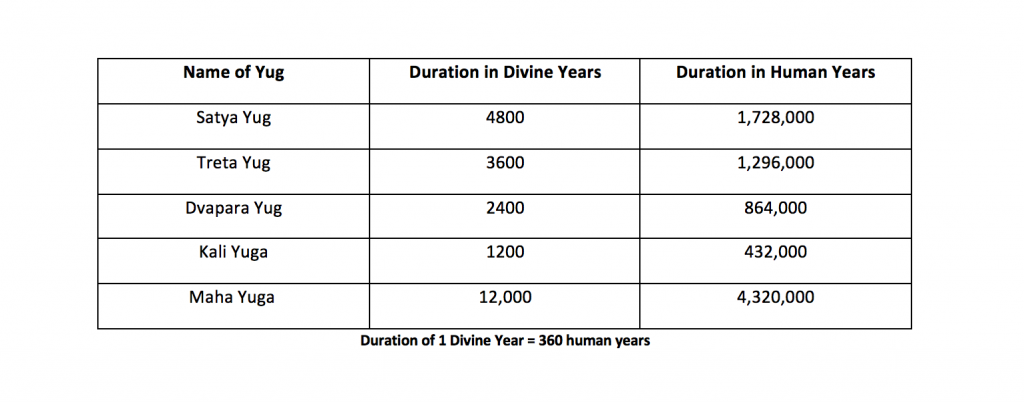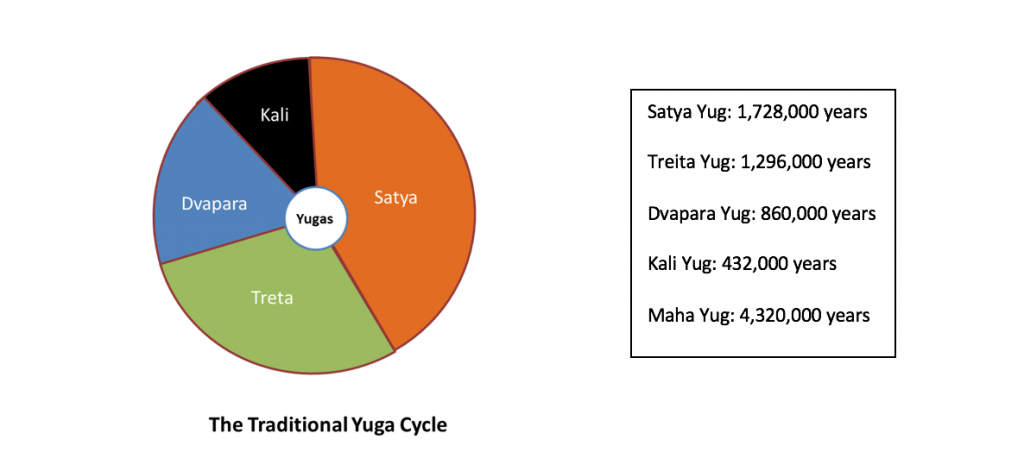Since the advent of the universe, mankind has always been interested in the commencement and conclusion of the world as well as in human nature.
Their endeavors have been directed toward discovering the conceptual mystery of creation with the help of different rational and philosophical ideologies along with various religious doctrines.
The ancient Vedic Seers of India have given us a theory of human development. They noted that life on earth is under the rule of vast cosmic forces. They seemed to be aware of infinite time and space. They used to measure time based on the revolutions of the earth, moon and the sun. Their complex calendar used the sun and moon to define the days, months and years.
Days and months were defined by the moon and years were defined by the sun. They believed that besides the light from our own sun, we also receive light from the center of the galaxy, the galactic sun with no visible frequencies (Vishnu Nabhi) which has a special influence on human consciousness. Humanity acts in harmony with this cosmic light.
This leads to significant periods of advance and decline in human consciousness, giving rise to certain time cycles, each called a yug or era.
According to ancient Indian Vedic and Puraic texts, the creation and destruction of the universe is a cyclic process.
Every cycle starts with creation, has its own time of expansion (the life time of the universe) and destruction. During each time of expansion, life in the universe is divided into four successive eras.
These four eras are differentiable based on their qualities. The names of these four eras have been derived from an ancient Vedic game of dice and counters.
The ancient philosophers believed that the world has been expanding in the same way as a matrix or network, the important fabrics of which are mainly made of the four successive eras.
The duration of these eras accords to ten units of time that are arranged in the ratio of 4:3:2:1 (i.e. the first era being four times longer than the last one).
The duration of the second era is three times and the third era is twice longer than the last era. Thus, the lengths of these four successive eras show a descending trend.
This downward tendency of time is accompanied with a descending trend in morality, with each era having its own specific qualities. These Indian eras are comparable to the ancient Greek Golden, Silver, Bronze and Iron Ages, namely:
The duration of this era is equal to the Golden Age which is 1,728,000 human years (4 x 432,000).
The duration of this era is equal to the Silver Age which is 1,296,000 human years (3 x 432,000).
The duration of this era is equal to the Bronze Age which has a length of 864,000 human years (2 x 432,000).
The duration of this era is equal to the Iron Age which has a length of 432,000 human years (1 x 432, 000).
The table below compares human years with Divine Years according to the ancient manuscripts:

Satya Yug (Golden Age)
The Satya Yug is called the era of honesty and perfection. It is an age of spiritual enlightenment.
Everyone in this duration is pious, devout and a believer in God and overwhelmed with positive virtues such as friendliness, kindness, mercy, justice and happiness. Purity and loyalty are emphasized in each individual’s life.
Negative traits such as pride, fear, desire, niggardliness and injustice are very limited. It is said that the Divine Being (Vishnu) announces his presence to human beings four times during this era.
It is also said that in this era people are free from disease and decay. Purana states that human stature in this era is about 21 cubits (each cubit is equal to 18 to 22 inches).
The Total ratio of karma performance (i.e. the group performance of mankind) in this era is 19 to 1, meaning that there is only 1 sin against 19 meritorious acts. In ancient literature, the symbol of morality for this period is a dharma cow standing on its four legs. The Satya Yug is also called as the Krita Yug since Krita is the winner in the game of dice and counters.
Treta Yug (Silver Age)
During this age the level of morality declines one fourth due to a decrease of purity. Gradually people show interest in materialistic activities. This era is called the mental age since some mental attitudes such as anger and deceit appear due to discontentment, which leads to quarrel between the followers of purity.
The God of the universe announces his presence thrice during this period. The total ratio of karma performance during this era is 15 to 5, meaning that there are 5 sins against 15 meritorious acts.
According to ancient literatures, the symbol of morality for this period is shown as a dharma cow standing on three legs.
Treta is the name of the third counter in the game of dice and counters. It is said that disease and decay start from this age. Human stature in this era is about 14 cubits.
Dvapara Yug (Bronze Age)
In this era mankind experiences a significant decline in spirituality. The level of purity declines, and our merits gradually become pale resulting in the spread of antagonism and immorality.
Faithlessness and stealth rise up against faith and purity. This age is also called the energy age. The total ratio of karma performance in this era are equal in measure, meaning that there are 10 meritorious acts against 10 sins. The God of the universe announces his presence twice during the Dvapara Yug.
Manuscripts from ancient times show the symbol of morality as a dharma cow standing on two legs during this period.
Dvapara is the name of the double counter of the dice game. Purana states that human stature in this era is about 7 cubits.
Kali Yug (Iron Age)
This era is called the age of darkness as well as the material age. Injustice and darkness dominate everywhere. Only one fourth of our former purity remains among the people.
Divine values and morality decline considerably.
Kali is the era of voracity, cupidity and jealousy. Famine, adversity and conflict overshadow human lives.
The ratio of meritorious acts to sin is 2 to 18 and the God of the universe announces his presence only once in this era.
The symbol of morality is shown as a dharma cow standing on one leg during this period.
Kali is the loser in the dice game. Purana states that human stature in this era is about 3.5 cubits.
The end of the Kali Yug is the termination of a full cycle of creation. It is said that the end of the Kali Yug will be followed by cataclysmic changes on earth leading to the collapse of civilization. Creation dissolves to put an end to the decline of purity.
Floods and storms overwhelm the whole world. While the truth of the human soul is everlasting, being turns to extinction.
Maha Yug
These four eras, together, constitute a Maha Yug, which means a Great Cycle. The duration of each Maha Yug is 4,320,000 human years.
Traditional Indian scriptures state that after the end of each Kali Yug, divine intervention will restore creation to its pristine state and another Satya Yug will arise. These scriptures describe the age of universe as a series of repeating Maha Yug cycles.

Some modern scholars like Sri. Yukteshwar and Yogananda present another theory. According to their theory, a complete cycle of Yuga consists of two halves, a descending half arc and an ascending half arc.
In one cycle of Maha Yug mankind as a whole descends in spiritual awareness from Satya to Kali Yug and again as a whole rises to increased spiritual awareness in an ascending manner from Kali to Satya Yuga. This theory was first given by Sri. Yukteshwar in his book The Holy Science in 1894.

Sri. Yukteshwar’s model differs from the traditional one. He explains that instead of always proceeding in the same order, the cycle of Yuga alternate between descending and ascending order.
He believed that the original scriptures gave the length of Yuga in ordinary years and not in units of divine years. He wrote that after completing 12,000 years of the descending cycle from Satya Yug to Kali Yug, the sequence reverses itself and an ascending cycle of 12,000 years begins which goes from Kali Yuga to Satya Yug.
The statements of these philosophers symbolize the fact that there are different ways of explaining the length of Yuga or that the ancient seers may have used different type of calendars to describe the length of Yuga.
After reviewing both the ancient and modern theories, it can be concluded that inherent in both theories is the idea that the whole of mankind or human consciousness passes through predetermined cycles which are fixed chronologically towards decline in spirituality and dharma.
This conclusion may seem pessimistic to humans. However, on the bright side, a truth seeker might be able to find a Golden Key to salvation from the same ancient scriptures. As individuals with a unique physical, mental and spiritual existence in our cosmic manifestation, our personal development of wisdom and consciousness greatly depends on our own karma (actions).
Karma determines each soul’s unique destiny by fixing our lost morality. According to the premise of karma, every action has its own consequence. Therefore, virtuous acts or pious activities (punya) have positive consequences for individuals on the path of developing wisdom, and practice of absolute virtue and spirituality.
It is necessary to assure the inner ascending journey of a single soul by our own choices and personally enjoy the quality of Satya Yug. In conclusion, humanity as a whole descends but individuals can personally ascend spiritually leading to Nirvana (Liberation).
The ancient Seers introduced the path of yoga for those who aspire for virtue and to regain the state of equilibrium where there is no instinct of anger, pride, lust etc. Yoga cultivates strength, awareness, poise, peace, love and truth in our daily lives, which are the qualities of the Satya Yug towards the final destination of Nirvana.

Yoga master with more than 30 years of experience in Iran and India, born in Ahmadabad India and grown up in a yoga family. Owner & Educational Director of Payam-e-Mehr International Yoga center.
